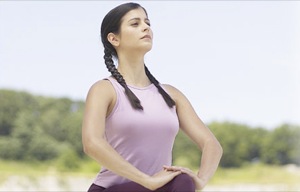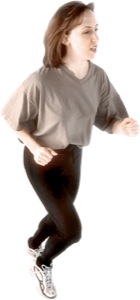health & sports
Fit for Life
The importance of breath
Published Thursday, 29-Nov-2007 in issue 1040
It’s obvious that breathing is an important function of the human body. While many people don’t completely understand the mechanisms involved in breath, it is well understood that without it, life ceases to exist. While this is common knowledge, what is a bit less apparent is the fact that many of us breathe incorrectly, and the negative impacts of improper breathing can lead to serious health risks.
The yogis have based an entire practice on breathing; a practice that has spanned thousands of years and is gaining momentum today. Martial artists utilize breath – or the “chi” – to maximize output and take advantage of energy supplies provided by breathing. People who meditate regularly use breath awareness to increase relaxation and mental clarity. Pilates enthusiasts use breath to provide support for the internal organs and bony structures such as the spine. This article will explore the importance of breathing and how you can make sure you are doing so properly.
The mechanism of breath
Before we begin this discussion on the many benefits of breathing, I want you to take a minute and monitor how you breathe. Sit calmly, put this newspaper down and count how many times you inhale and exhale over the course of one minute. Now that you have completed this exercise, what are your thoughts? Was sitting still and concentrating on breath somewhat awkward? Did you notice any difference in mood or state of being? Now, how many breaths did you count? According to a research report published in the May 1998 issue of The Lancet, scientists determined that optimal breath rate is about six deep breaths per minute. The national average, however, is two to three times that amount. That means that most of us aren’t breathing deeply enough to supply the body with adequate oxygen, which can hamper the body’s ability to function properly. Without oxygen, the body dies, so it is very important to make sure that you have enough oxygen in your body so it can flourish.
Breathing and fitness
Think back to your last exercise session. Do you recall your breathing rate? Most likely you do not. Many of us can barely get through an hour’s worth of exercise, let alone pay attention to what’s happening with the body. But without enough oxygen, you can impair a successful workout and place your body at risk of serious injury. First, energy is absolutely necessary for exercise. The study published in The Lancet also determined that people who focused on breath were able to complete an exercise session more successfully and efficiently. Without adequate oxygen supply, the body loses its ability to metabolize energy stores and cannot perform a movement to its best ability.
Another problem that can arise during exercise is when a person holds his breath while performing a movement such as the bench press or pull up. While professional weight lifters often use this technique (known as the Valsalva maneuver) to increase intra-abdominal support to prevent injury, the average exerciser who holds his breath risks placing excess strain on the heart through a temporary increase in blood pressure. According to the National Strength and Conditioning Association, a leading certifying agency for personal trainers, a person holding his breath while exercising can also initiate dizziness, rapid-onset fatigue, blood vessel rupture, disorientation and even blackouts. Next time you hit the gym or go for a run, try to focus on breath the entire time. Weight lifters, or those exercisers performing short-term movements, should attempt to inhale prior to strenuous activity and then exhale throughout the exertion phase. For example, when preparing for a biceps curl, take a deep breath and then exhale as you bring the dumbbells up toward your shoulders. Exhale as you return the weights to the start position. Long-distance runners might link breath rate with stride. Practice inhaling for about four strides, and then exhale for six. Both techniques may be difficult to adopt at first, especially if you’re not used to focusing on breath, but you’ll most likely improve energy levels for a more successful and satisfying workout.
Breathing and relaxation
In today’s busy society, more people are stressed than ever before. Excess stress can lead to high blood pressure, heart problems and a host of other dangerous side effects. One way to help decrease stress and tension in your life is to ensure that you are breathing correctly. Often, many of us go through our days not recognizing that we are taking in only enough oxygen for basic survival. Recognizing this, yogis and meditators develop stress-reducing practices that focus on breathing for relaxation. Those of you who take care of animals may notice that, when settling down for a nap, dogs and cats often let out a big exhalation or sigh. This technique helps activate the parasympathetic nervous system which is responsible for the “relaxation response.” The idea is to inhale for several seconds and then exhale for a longer duration than the inhale. Go ahead and give it a try. Breathe in for about six counts and then exhale for eight to 10 counts. Perform several repetitions and then see if you notice any difference in your mind and body.
Yawning during exercise
While yawning has long been thought of as the body’s way of alerting us that we are tired or require more oxygen intake, researchers warn that chronic yawning during exercise may be a sign of a deeper problem. When a person yawns, he experiences a temporary spike in heart and blood pressure, which can be very dangerous, especially during tasks in which significant exertion is required. While the pathology of the condition is still unknown, high blood and heart pressure can lead to serious heart conditions.
Proper breathing technique
Now that you have an understanding of the many important benefits of breathing properly, here are some tips from www.healthcentral.com to help you determine if your intake needs an upgrade.
Lie on your back with your knees bent and your feet flat on the floor. (Although you can do this exercise while sitting or standing, it’s easiest to practice by lying down at first.)
Place your hands on your abdomen.
Breathe in through your nose, counting to four. Your hands should rise as your abdomen fills with air.
Hold the breath for a few seconds.
Exhale slowly through your mouth, counting to four. Your hands should go down as your abdomen deflates.
Practice this exercise for a minimum of five minutes at a time, at least two or three times a day. You’ve probably been breathing improperly for a long time, so it may take a while to retrain your body to breathe properly without you thinking about it.
|
|
Copyright © 2003-2025 Uptown Publications



